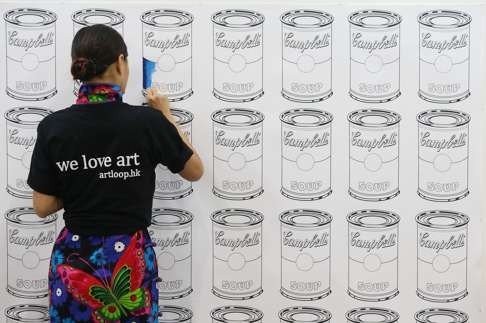Click and collect: how the digital age is changing the global art market

In 2014, Jehan Chu acquired an artwork by Vietnamese-born Danish artist Danh Vo via an internet platform based in the United States. It was the biggest online art purchase the art adviser had made since he began shopping for art online in 2011.
“They simply had the work I wanted when I wanted it,” Chu, director of Vermillion Art Collections, explains.
While he declines to reveal the details of the work by Vo, he says he has been acquiring a diverse range of artworks online – including “obscure” works by American artist Petra Cortright, a key figure of the recent “post-internet” art movement.
“I have bought artworks priced at mid to high five-digit US dollars online, and have sold [artworks] online as well. Trading art online is a great addition to the normal art and auction schedule,” he says. “It adds a welcome dimension to buying art.”
The digital world is the next frontier of the global art market. With strong growth in online art sales reported in recent years amid people’s increasing consumption of the digital medium, auction houses, art fairs and online art platforms have begun boosting their presence online in order to capture cash-rich young and new collectors.
And the future lies in Asia, according to industry insiders, who say the growth in online art sales is strongest in this part of the world – particularly in Hong Kong and the mainland – as it is a relatively younger region with buyers who are more receptive towards technology and the online world.
It has taken the art world a long time to embrace the digital realm, says Will Ramsay, founder and CEO of the Affordable Art Fairs. He says among all retail businesses, art was the last to be traded online comfortably.

“When retail of clothing went online some five years ago, no one believed in it. But now the clothing world has overcome that and consumers have changed their habits,” Ramsay says. “Now it’s the art world’s turn.”
The latest report from The European Fine Art Fair (TEFAF) and the Hiscox Online Art Trade Report show that online art sales soared last year despite a 7 per cent drop in the global art market from US$68.2 billion in 2014 to US$63.8 billion in 2015.
The TEFAF report estimated that online art sales reached US$4.7 billion last year, accounting for 7 per cent of global art and antique sales. Hiscox reported a 24 per cent growth in the online art market in 2015, with estimated total sales at US$3.27 billion. Based on this growth rate, the online art market could reach US$9.58 billion in 2020.
Online art sales include sales conducted by traditional art dealers and galleries as well as auction houses on their own accounts or third-party platforms. Auction houses Christie’s and Sotheby’s are among the key players.
Hiscox ranked Christie’s LIVE, the auctioneer’s online live bidding platform, the world’s top digital sales platform. Christie’s reported an 11 per cent increase in digital sales in 2015 and a 10 per cent rise in the number of digital buyers.
The auction house said 20 per cent of new buyers shopped digitally. Digital buyers from Asia grew 12 per cent, with their spending up by 34 per cent.
John Auerbach, global head of digital and e-commerce at Christie’s, says art has a higher price point so it has taken people longer to be comfortable spending more online. And technological advances have changed the game.
“Last year, of the 1.5 million visitors to our online auctions, 80 per cent of them were new to the company, and Asia is the fastest growing region,” he says.
“Ten years ago you wanted to see something in person but now people are getting more comfortable buying art from great images.
“Now you can have multiple views and 360 imagery of an artwork. You can get an almost real life experience virtually and can see things even the naked eye can’t see.”

Auerbach says digital buyers are on average 10 years younger than traditional auction art buyers and they have diverse interests, from ceramics by Pablo Picasso starting from a few thousand US dollars and wine from several hundred British pounds, to high-priced pieces like a Richard Serra work that was sold for close to US$2 million online.
Sotheby’s is also experiencing tremendous growth online. David Goodman, executive vice-president of digital development and marketing at Sotheby’s in New York, says the auction house saw a 44 per cent increase in lots sold online in 2015, a 52 per cent rise in the number of online bidders and 36 per cent growth in buyers.
“This drove online sales of over US$100 million, the first time Sotheby’s had broken that barrier,” says Goodman, adding that 2016 has already seen a 41 per cent rise in online bidders, leading to an 82 per cent increase in lots sold online in its recent Hong Kong spring sales.
Hiscox reports that digital transactions focus mainly on artworks with a relatively lower price point, with 82 per cent of the galleries saying the average price was below £10,000 (HK$11,150). But Goodman also points to high-priced sales, such as a US$3.3 million diamond and platinum ring, a Marc Chagall painting and even a 1955 Mercedes 300 SL .
While century-old auction houses are succeeding in their digital business ventures, new pure-play platforms are also earning trust from art buyers.
Chu says: “Online art platforms like Paddle8 and Artsy have made great strides in expanding the lower end of the art market, creating more liquidity and transparency and creating markets for works that may have struggled to find buyers.”
Artsy, an art-tech start-up where Wendi Murdoch serves as a co-founder and board member, was ranked the world’s No 2 by Hiscox. Other big-name investors and advisers include the Rockefeller family, art dealer Larry Gagosian and Rich Barton, founder of Expedia, Glassdoor and Zillow.
Since its launch in 2012, Artsy has had more than 32 million visits. It says it acts as a resource for learning and collecting art online, providing access to more than 4,000 galleries, 60 art fairs and over 600 museum collections.
More than 230,000 artworks featured in the platform – mostly offered by galleries – are for sale, but the platform does not take commission; galleries have to pay a monthly subscription fee, one of the revenue channels.
Artsy’s communications manager Graham Newhall says last year one of the top-priced sales was a US$1.4 million deal between a London gallery and a US-based collector. In the first quarter of 2016 he says there have been hundreds of gallery sales each month, including multiple sales priced at six-digit US dollars.
Art fairs are also making the online move. Ramsay says the Affordable Art Fair is launching an e-commerce platform that will complement the fair, offering visitors extra information about the fair, images of artworks and what will still be available for sale after fair is over.
But despite the online art sales boom, they have yet to shake the traditional art market to the core. Gallerist and art adviser Angela Li says the majority of art sales are still conducted in the traditional way, but she does receive more inquiries via these new art platforms. But she has still to see a significant change in the gallery business model.
“The only exception is with mainland Chinese collectors,” Li says. “Whether they are young, old, new or experienced, they are much more comfortable seeing and buying art via WeChat.”
Artron, the mainland’s largest art platform, is also making aggressive moves, says Vincent Chan of Leo Gallery, offering editorial content as well as sales services. Chan, however, does not think online art sales can replace traditional sales, particularly galleries.
“It is a high-end customer service and relationship retail business. Buyers need that special feeling and moment to buy art.”
He recognises that online art sales will grow in the future. “But it is yet to be a threat to galleries, at least not in the coming five years.”
Hiscox surveyed 672 art buyers aged 20 to 65 years. Seventy per cent said the average price point for an artwork they purchased was £5,000 or under. Paintings and prints were the most popular online purchases, with 72 per cent buying such works. Only 18 per cent had bought new media art.
But the survey revealed that 19 per cent of those aged 35 or under made their first art purchase online, up 9 per cent in the previous year. Some 49 per cent had made two to five purchases online over the last 12 months, and 92 per cent said they would buy more in the coming 12 months.
While many considered art as an investment, 92 per cent bought art because of emotional satisfaction. Only 57 per cent said they bought art for investment purposes. Some 44 per cent, however, considered art as a status or identity symbol when it came to deciding whether to buy art.
Social media plays a vital role in drawing their attention. Some 42 per cent said they were influenced by social media when buying art online last year, compared to 27 per cent in 2014. And 85 per cent had bought art from one to three platforms. This group of young buyers will change the game of the art market, Chan says.
Chu says the rise of online platforms has given more exposure to artists and artworks that were previously under the radar, such as Hong Kong art. He says Hong Kong artists and gallerists should make the most of the opportunity.
“Online platforms greatly enhance the limited number of channels that Hong Kong art is featured in,” Chu says.
“With high rent and low prices for local artists, online provides a much more supportive environment despite the obvious drawback of not being able to see the art in real life. But it’s still greatly underutilised by local galleries.”
Despite the online art market having a bright future, it will take a long time for it to revolutionise the traditional art market.
“There are many inefficiencies and rituals in the art market that are begging for a reboot, but the art world has resisted change for centuries,” Chu says.
“Until online art sales prove that it can sell more than traditional gallery and increasingly art fair and auction channels, the revolution will have to wait.”